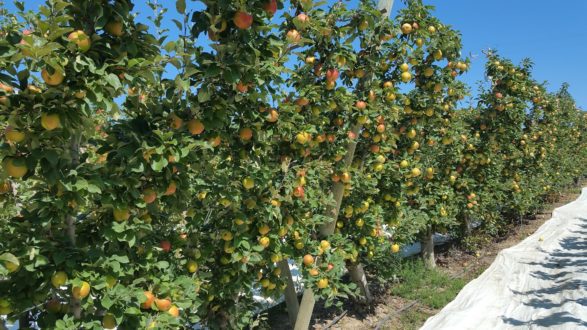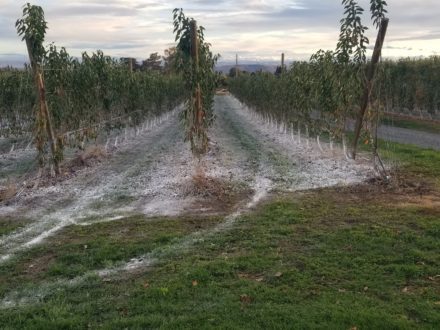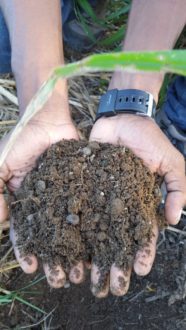

Feb 13, 2023Growers learn about adopting regenerative practices
Regenerative agriculture involves growing healthier plants through improving soil health to reduce pest and weed pressures.
Participants in the Soilcraft Regenerative Agriculture conference Jan. 16-17 in Pasco, Washington, learned about tools they can use to lower pesticide use.


“So many times, growers are only applying nitrogen when the plants want phosphorous because they’re building flowers and seed,” said Mason Gordon, president of Zillah, Washington-based Soilcraft crop consultancy, soil sampling and certified crop advising service.
Gordon said transitioning to regenerative is a process that involves replacing every input that’s toxic.
“That doesn’t mean you’re certified organic, but it means you as a grower are using things that are non-toxic,” he said. “Foliar feedings at the right time with the right products and the right ingredients are huge and critical.”
In recent years, growing areas including Washington have experienced record heat and the issues it brings. Growers in a regenerative model apply a blend of foliar applications, including bioflavonoids, silica, seaweed, amino acids, enzymes, fulvic acids and humic acids, elements which can positively influence plants that have experienced heat stress and excessive salt.
Energy boost
Because they provided their plants with specific energy needs, those growers fared better than others, Gordon said.
“It’s like sports performers who are into being healthy,” he said. “They have to get the right rest and do all these things so they can be at their peak performance because when in competition, they’re under an extreme amount of stress. Our crops are no different.”
In a talk on why insects do not attack healthy plants and how electrical conductivity of soils affects plant growth, Thomas Dykstra of Gainesville, Florida-based Dykstra Laboratories discussed ways growers can test their plants.


Visual observations, including judging color, fast growth and flowering aren’t accurate and don’t provide standalone indications of plant health. Inexpensive handheld leaf brix refractometers, for example, can provide immediate plant health results, Dykstra said.
Invading forces would spread salt on conquered lands before departing, he said, and application of high salt fertilizers compromises plant health. Many basic NPK (nitrogen, phosphorus and potassium) fertilizers are considered high in salt, and can burn roots and prevent water uptake. Tip burn can signal excessive conductivity.
Green beans and leafy greens are least able to handle salt, with sweet corn, potatoes and tomatoes slightly more tolerant. Kochia thistles can handle high levels of salt and take high conductivity better than other plants.
“High conductivity plants result in highly-conductive plants,” Dykstra said. “We cannot say salt is bad. We can simply say too much is bad.”
Exposure of plants to humic substances increases nitrate transporters, which move nutrients in cell membranes, boosting root numbers and nitrate absorption, said Rich Lamar, senior director of Humic Research at Bio Huma Netics, who discussed the science behind humic substances.
Humic factor
Because a grower won’t know when plants will experience stress during the growing season, planting biostimulants provides insurance. When plants come under stress, the balance between reactive oxygen species (ROS) can damage tissue, disrupting the balance between ROS production and antioxidants.
“If the plant can’t return it to proper balance, it won’t produce as much,” Lamar said. “If it’s so bad and so out of balance, the plant will die.”
It’s all about keeping the plant’s redox homeostasis, the exposure of an organism to low doses of stress, he said.
Dragan Macura, founder of organic fertilizer manufacturer AgroThrive, which uses fish inedibles, cited studies showing how organic fertilizers better protect and interact with plants than conventional products.
Blending organic fertilizers with conventional fertilizers improves plant/microbe interaction in the rhizosphere, the area of soil surrounding plant roots, he said. In grapes, the blending can improve yields, lower heavy metals in the soil and leaves, and improve the quality of grape must (the first step in winemaking), leading to better wine quality, Macura said.
Issac Carlson, a Pasco area wheat grower who diversified into winegrapes, discussed how he transitioned to farming regeneratively. One step is using a fish-based fertilizer.
“I was always told by people that yes, you may be able to go organic, but, eventually, the weeds will get you,” he said. “You will have to go back to conventional to control the weeds.”
Carlson added various regenerative components to his conventional spray program, saw how it worked and added more to reduce toxic material use.
“I was told by other grape farmers that if you have bindweed, a tough one, it’s like a death sentence in that you can’t ever get out of it, it goes up the canopy and engulfs the grapes,” Carlson said. “But what I’ve learned in seven years, instead of what I was told, that weeds will kill you and you will have to go back to conventional, the weeds are actually getting less. They’re still there, but are not increasing. The pressure is decreasing. It’s very manageable now.”
Gordon said Carlson’s experience in reducing levels of fertilizers and pesticides makes his plants better.
“When you begin to replace and eliminate all toxic materials that have secondary and negative side effects, then you become regenerative organic,” Gordon said. “I don’t care if you’re certified or not. I am talking about growing things in a non-toxic manner that you can eat or get anything on you or lick it, that you’re applying to your crops. This can be done at once, but most of the time it’s a transition process.”
— Doug Ohlemeier, assistant editor
Top photo: Blending organic and conventional fertilizers in grape production can improve yields, lower heavy metals in the soil and leaves, and improve the quality of fruit, ultimately leading to better wine quality. Photos: Soilcraft.
Second photo: Certifications for organic production and a regenerative agriculture model are not the same. Regenerative agriculture involves removing all toxic materials from the process, said Mason Gordon, president of Zillah, Washington-based Soilcraft crop consultancy.
Third photo: Participants in the Soilcraft Regenerative Agriculture conference Jan. 16-17 learned about tools they can use to lower pesticide use.
Bottom photo: Regenerative agriculture focuses on soil health to reduce weed and pest pressures, and using organic herbicides and pesticides.















